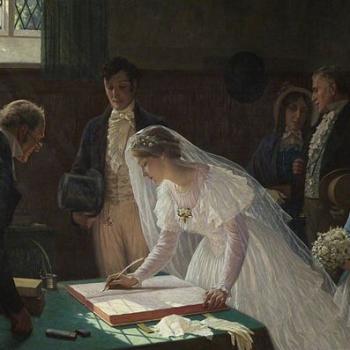Recently my colleague Kyle has posted a discussion of a video on the virtue of modesty. I found it fascinating as a cultural artifact, since it assumes without question so many of the many tropes about modesty which dominate in discussions of this virtue by conservative Christians. In particular, it frames modesty as a female virtue. Or, another way of looking at it is to use a bit of feminist analysis: it presumes that the male gaze is normative: both men and women view women only through the perspective of men; women’s views of themselves are marginalized and replaced by how they are told to view themselves by men.
This brought me back to an unfinished post I started last summer after a visit to Madrid. One of the red light districts in Madrid is Calle Montera, stretching south from Gran Via to Puerta del Sol. For a 2-3 block stretch it is densely populated by prostitutes and their clients, along with large numbers of tourists and Madrilenos who are just passing through. The boundaries of the region are unmarked but as real as a line painted on the street. Within it the police turn a blind eye to solicitation but the women know to not step outside this zone.
Passing through Calle Montera last summer, I was struck by the sheer numbers of prostitutes. In previous years I have seen a lot, but this year there were many more. (I presume that this is a result of the economic situation.) I was also struck by the distinctive way the women were dressed: in particular by their shoes. Every prostitute that I saw was wearing 5 inch heels, and a few were tottering (literally!) on heels that were at least 6 inches high. In previous years I recall that go-go boots were the distinctive footwear.
I suspect that one reason for the distinctive footwear is to distinguish themselves from the other women passing through, including women heading to the dance clubs and bars in the neighborhood south of Puerta del Sol and who are dressed in “club wear”: short skirts and dresses, tight jeans or leggings, but with sandals or low heeled shoes. Their shoes and dress both establish their identity and serve as advertising. They are a self-aware and self-identified commodity. They want to be looked at but only for the purpose of initiating a commercial transaction. They are commodifying themselves for the male gaze.
This distinguishes them from the the women heading to the clubs who, presumably, want to be looked at but for different reasons. If we take the argument of the male gaze seriously, then they want to be looked at by men, for men’s reasons: they make themselves over to fulfill men’s standards of sexy and beautiful. They may be self-aware as the prostitutes of Calle Montera are, or they may being doing it unconsciously, because this is simply what women are supposed to do. The video Kyle posted sets different standards, but the effect is the same: women are to see themselves as these young men see them, and their (male) gaze is determinative of their worth. (As the song implies, girls who don’t meet their visual standard lack integrity.)
Unacknowledged, the male gaze makes any discussion of modesty problematic, since it can reduce the virtue of modesty to a dress code for women. A rather extreme example of this is the blog Modesty Rediscovered: check out their style inspirations and the advice, purportedly from Pius XII, on women’s dress. My personal favorite from this list:
A modest outfit conceals rather than reveal the figure of the wearer; they do not unduly emphasize the parts of the body.
But even if we move away from this and take into account the male gaze, discussions of modesty seem to flounder. A good example of this comes from a pair of blogs: Sarah over the Moon and Rage Against the Minivan. Both are written by Christian women, but in a pair of posts last year they crossed swords over modesty. Rage started it with a discussion of an incident in which a male friend of hers goes clubbing and encounters a woman with a very low cut top and large breasts breasts which she has covered with glitter infused body oil. Or, as she trenchantly puts it: “she had glitter on her tits.” The woman catches the man staring at her breasts and calls him out. The question quickly became how to interpret this event. Rage argued:
[W]hen a woman wears revealing clothing, then gets angry when men notice, that’s not cool either. It makes her a hypocrite….When a woman goes after a man for noticing her deep v, that’s shaming him. Trading shame for shame is not a win for womankind, my friends. A woman can wear whatever she wants. More power to her. What she can’t do is expect men not to notice. Most men can regard her charms then move on. If she wears a micromini and claims to not want a reaction from men, I’m going to straight up call her a liar but I’m not going to call her wrong for wearing it….[I]f you are going to wear what could be legitimately called “suggestive”, then just own it. Most men can appreciate the way you look and not lust after you, but don’t shame them for their appreciation.
Sarah argued forcefully against this position, writing
Though…the author of this post [does not] promote rape and sexual assault, [she] blatantly tell[s] women that their clothing choices can forfeit their right to bodily autonomy. Rapists and those who support them use THE SAME thinking to get away with rape and it works. Time and time again it works….This line of thinking doesn’t start with “that girl in the mini-skirt was asking to be raped.” It starts small. It starts with the idea that women don’t have the right to define their clothing choices. It starts with the idea that clothing can take away someone’s right to complain when they feel violated. It starts there….People–especially those in groups that face systemic violence–have the right to express discomfort. They have the right to “shame” those that they feel violated by. YES, even if they have glitter on their boobs. A truly “nice” guy who truly means no harm will respect that, apologize, and look away. Saying that clothing can take away the right to bodily autonomy is dangerous, and it is participating it rape culture.
Reading both posts (and I recommend reading them at length, including the comments) points out that any discussion of modesty must contend with the reality of the male gaze. We need to talk about what modesty means in the context of social structures which are asymmetric and privilege men, but we also need to talk about what we want modesty to mean. Sarah wants to reject the normative power of the male gaze and give women the total autonomy to dress as they want. As she put it in an earlier post entitled Feminism and Abstinence:
A feminist practice of abstinence…would reject any claim that women dressing immodestly gives men a right to look at them.
Women are free to choose what they wear and define for themselves what it means. This is a remarkably libertarian, individualistic position. The rest of this post about abstinence has a lot of thoughtful suggestions, but this is not one of them. Sarah in her first post makes the point that dress is communication, but then fails to follow through: communication cannot be separated from the milieu in which it occurs.
Rage, on the other hand, correctly wants to position the meaning within a broader social framework: she also rejects the male gaze as normative, but realizes that men will indeed look and that they will do so in a social setting which defines beautiful and sexy in certain ways. Women have to be prepared to accept the fact that if they speak with the “vocabulary” of the dominant culture, one infused by the male gaze, then they will not always be understood in the ways they intend. Or, as my wife pointed out when I sketched this post to her: the women with the glitter probably never thought of this as anything except some fun makeup. But it had other meanings which she must acknowledge exist, even if she rejects them.
Dress is communication: whether explicitly, as in the case of the prostitutes of Calle Montera, or implicitly, when men and women just follow the latest fashions as they get ready to go out on a Friday night. But before we can establish appropriate dress codes, we to move the discussion beyond the male gaze: can we define, as Catholics, an ethos of modesty that makes of it a non-gender specific virtue? Can we establish new norms for understanding dress and behavior of both men and women, one based in mutuality and that explicitly refuses to accept the terms imposed by the male gaze? I hope that we can, though the attempts I have run across mostly fail. A quick search this morning for discussions of male modesty came up with a few interesting attempts, including this blog, Guys on Modesty. But even here the discussion is shaped by a quote from Pope John Paul II that seems to frame virtue in terms of the male gaze:
God assigns as a duty to every man the dignity of every woman. (*)
So, I end with a question, since I don’t have any answers: what are we to do? How can we make modesty a beautiful virtue for both men and women while leaving behind this notion that women are passive and men define the terms?
(*) As an aside: I cannot find an original source for this quote, which seems to have come from a speech at an audience and not from any of his encyclicals or letters.)













